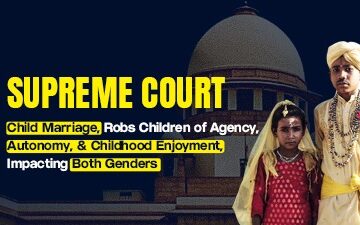Introduction:
Marriage in India is not just a union between two individuals but it is a fusion of two families, entwined in diverse traditions shaped by communities and religions. But when it comes to the legal landscape, personal laws govern the intricate matters of marriage and divorce, each with its own set of rules based on their own religious laws.
There are different types of divorce in India which is based on religious laws. Hence, understanding the process of divorce in India is crucial, as it is not as simple as mutually deciding to part ways. Generally, there is concept of Mutual Divorce in India which occurs when both spouses agree to terminate their marital responsibilities. Also, legal concepts such as judicial separation and divorce have certain set of rules that differ based on applicable laws. In terms of the divorce process, the authority to confirm a legal status lies with the courts in India. Therefore, individuals cannot independently decide to end their marital union and live separately. Trust us this is not how divorce proceedings work, especially not in India.
This particular blog aims to shed light on the journey that couples must navigate when contemplating the end of their marital journey.
Things to Consider Before Approaching Court:
Reconciliation Matters:
Before diving into the challenging path to divorce proceedings in India, consider attempting reconciliation. Jumping into the legal route without exploring the possibility of saving the marriage may worsen the situation.
Mutual Consent Divorce Is Ideal:
If reconciliation is not an option, strive for mutual consent divorce in India. It makes the separation smoother and less contentious.
Grounds for Contested Divorce:
If one party resists the divorce, grounds for contested divorce must be established. Collecting evidence becomes crucial in such cases for the spouse who still want to part ways.
Clarify Grounds for Contested Divorce:
If contesting, be prepared to satisfy the court on the chosen grounds, which means if you are in a disagreement and contesting the divorce, be ready to convince the court about why you want to end the marriage. Whether it is physical or mental cruelty as ground for divorce, evidence and clarity are crucial to support the case.
Time and Financial Considerations:
Recognize that contested divorces take longer and involve higher financial risks. Be prepared for personal expenses based on case complexity.
Child Custody Decisions:
Couples with children must decide on child custody arrangements mutually. Child custody battles are harmful to children even though sometimes it is hard to avoid if the parents are divorcing.
Divorce Procedure in India:
In cinematic portrayals, when there is a case of adultery, couples often quickly decide to go for a mutual consent divorce and also make it look so simple and uncomplicated. However, the reality of divorces, particularly in regions like India, is more intricate due to cultural values associated with lifelong commitment. Legal frameworks are intentionally designed to prevent impulsive marital dissolution. In cases where one spouse wishes to continue the marriage while the other seeks termination, legal proceedings can be lengthy. The party seeking divorce must substantiate one of the recognized grounds for divorce in India, meeting a strict burden of proof. However, if the party seeking divorce fails to provide necessary evidence, the party may result in being compelled to remain in the marriage against their will. Even in consented mutual divorce in India, reconciliation is prioritized unless circumstances are severe and beyond resolution. Thus, the procedural aspects of divorces in India consider the potential for spousal reunion.
Divorce by Mutual Consent:
- Court Involvement:
Even for mutual consent, divorce is granted through a court. While family courts may not necessitate
a lawyer however consulting via mutual divorce lawyers can provide clarity on legal technicalities. - Separation Period:
According to Hindu Marriage Act 1955, a one-year separation is required to file for a divorce in India,
during which there should be no sexual intercourse between the spouses. However, flexibility exists
based on the overall welfare of individuals. - Initiating the Process:
The process starts with a jointly filed divorce petition in the appropriate court. - First and Second Motions:
The first motion is followed by a six-month cooling-off period for possible reconciliation. The second
motion leads to the final hearing and the passing of the decree. - Finality of Mutual Divorce:
Mutual divorce decrees are obtained through court proceedings with the agreement of both parties
involved. Moreover, appeals against the court’s decision are generally not allowed, ensuring that the
agreed-upon terms are legally binding and final.
Contested Divorce Procedure in India:
In India, situations where one party desires a divorce while the other remains willing to terminate the marriage through judicial separation, a conflict ensues as both parties present their perspectives on the facts. The party initiating the divorce provides the court with reasons asserting the untenability of the marriage and substantiates one of the legally recognized grounds for divorce in India. The other party is not inherently obligated to substantiate claims but may choose to demonstrate the inaccuracies in the allegations made by the party seeking divorce. The procedural steps in such contested divorce cases are outlined as follows:
- Legal Representation:
Hire a local lawyer for representation, ensuring they are experienced in handling divorce cases in the relevant jurisdiction. If you are in Assam then an experienced divorce lawyer in Assam will help bring the matter to court. - Legal Notice:
Before court intervention, serve a legal notice for divorce, emphasizing the preference for a mutual settlement. If you are in Guwahati, Assam then an experienced divorce lawyer in Guwahati, Assam will help serve a legal notice to the other party. - Filing the Petition:
If no settlement is reached, file a divorce petition in the court of appropriate jurisdiction. Under the Hindu Marriage Act, 1955, the court for such matters can be located where the marriage occurred, where the matrimonial home is, or where the couple last lived together as spouses. - Summons and Reconciliation:
Summons are served, and attempts are made for reconciliation during court appearances. - Trial Proceedings:
If reconciliation/agreement of both the party fails, the trial begins, involving an investigation, cross- examination and the presentation of evidence. - Court Decision:
The court makes a decision based on the applicable laws, facts and practices. The marriage either continues or ends based on the evidence presented by both the parties. - Appeal Process:
An aggrieved party can appeal to a higher court if he/she is dissatisfied with the decision made by the lower court.
Conclusion:
Understanding the divorce proceedings in India is crucial for those navigating the complex process. Whether you opt for a mutual divorce or contested divorce, being aware of the steps involved can help you anticipate challenges and make informed decisions. Divorce is undoubtedly a challenging journey, but knowing the path ahead can provide clarity and pave the way for a smoother transition during the journey.


